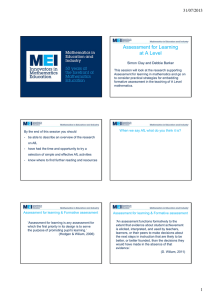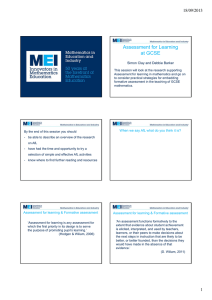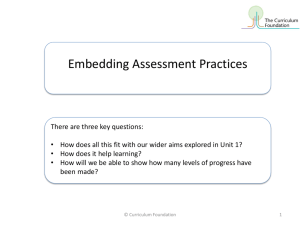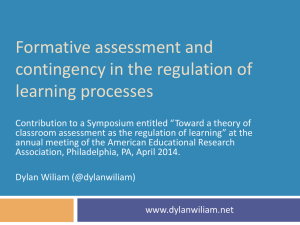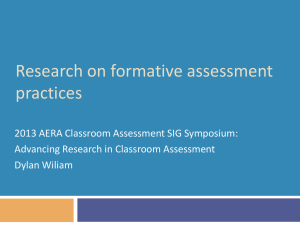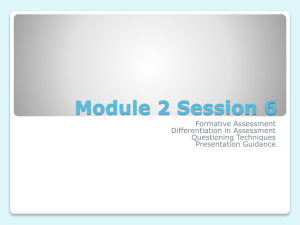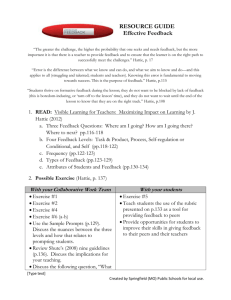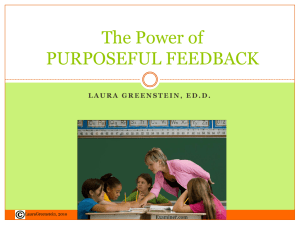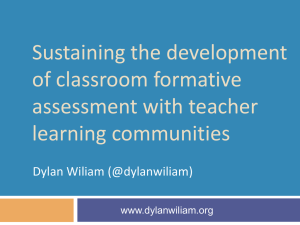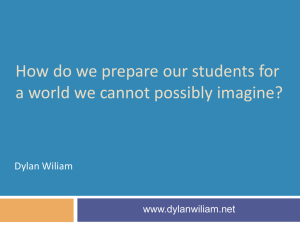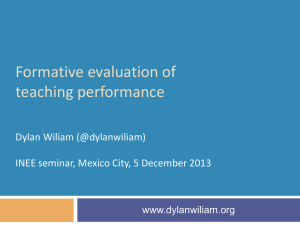What is formative assessment?
advertisement
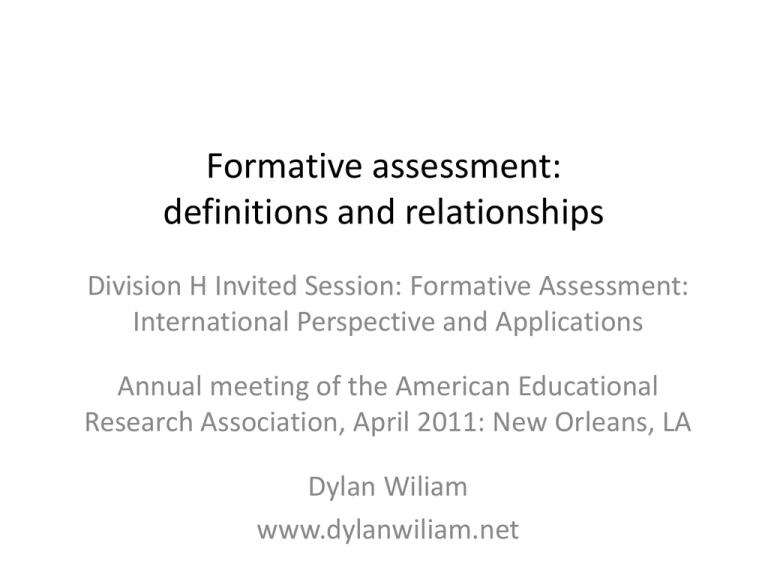
Formative assessment: definitions and relationships Division H Invited Session: Formative Assessment: International Perspective and Applications Annual meeting of the American Educational Research Association, April 2011: New Orleans, LA Dylan Wiliam www.dylanwiliam.net Origins and antecedents Feedback (Wiener, 1948) • Developing range-finders for anti-aircraft guns • Effective action requires a closed system within which o Actions taken within the system are evaluated o Evaluation of the actions leads to modification of future actions • Two kinds of loops o Positive (bad: leads to collapse or explosive growth) o Negative (good: leads to stability) • “Feedback is information about the gap between the actual level and the reference level of a system parameter which is used to alter the gap in some way” (Ramaprasad, 1983 p. 4) Feedback and instructional correctives (Bloom) What’s wrong with the feedback metaphor? In education Feedback is any information given to the student about their current performance … or at best, information that compares current performance with desired performance Much rarer is information that can be used by learners to improve In engineering That’s just data That’s just a thermostat That’s a feedback system A blossoming of research reviews… Fuchs & Fuchs (1986) Natriello (1987) Crooks (1988) Bangert-Drowns, et al. (1991) Dempster (1991, 1992) Elshout-Mohr (1994) Kluger & DeNisi (1996) Black & Wiliam (1998) Nyquist (2003) Brookhart (2004) Allal & Lopez (2005) Köller (2005) Brookhart (2007) Wiliam (2007) Hattie & Timperley (2007) Shute (2008) Effects of feedback Kluger & DeNisi (1996) review of3000 research reports Excluding those: • • • • • without adequate controls with poor design with fewer than 10 participants where performance was not measured without details of effect sizes left 131 reports, 607 effect sizes, involving 23,363 observations of 12,652 individuals On average, feedback increases achievement (d =0.41) • Effect sizes highly variable (sd>1) • 38% (50 out of 131) of effect sizes were negative Effects of formative assessment Standardized effect size: differences in means, measured in population standard deviations Source Kluger & DeNisi (1996) Effect size 0.41 Black &Wiliam (1998) Wiliam et al., (2004) Hattie & Timperley (2007) 0.4 to 0.7 0.32 0.96 Shute (2008) 0.4 to 0.8 Problems with effect sizes Restriction of range Sensitivity to instruction Ambiguous comparisons Definitions of formative assessment We use the general term assessment to refer to all those activities undertaken by teachers—and by their students in assessing themselves—that provide information to be used as feedback to modify teaching and learning activities. Such assessment becomes formative assessment when the evidence is actually used to adapt the teaching to meet student needs” (Black & Wiliam, 1998 p. 140) “the process used by teachers and students to recognise and respond to student learning in order to enhance that learning, during the learning” (Cowie & Bell, 1999 p. 32) “assessment carried out during the instructional process for the purpose of improving teaching or learning” (Shepard et al., 2005 p. 275) “Formative assessment refers to frequent, interactive assessments of students’ progress and understanding to identify learning needs and adjust teaching appropriately” (Looney, 2005, p. 21) “A formative assessment is a tool that teachers use to measure student grasp of specific topics and skills they are teaching. It’s a ‘midstream’ tool to identify specific student misconceptions and mistakes while the material is being taught” (Kahl, 2005 p. 11) “Assessment for Learning is the process of seeking and interpreting evidence for use by learners and their teachers to decide where the learners are in their learning, where they need to go and how best to get there” (Broadfoot et al., 2002 pp. 2-3) Assessment for learning is any assessment for which the first priority in its design and practice is to serve the purpose of promoting students’ learning. It thus differs from assessment designed primarily to serve the purposes of accountability, or of ranking, or of certifying competence. An assessment activity can help learning if it provides information that teachers and their students can use as feedback in assessing themselves and one another and in modifying the teaching and learning activities in which they are engaged. Such assessment becomes “formative assessment” when the evidence is actually used to adapt the teaching work to meet learning needs. (Black et al., 2004 p. 10) Which of these is formative? A. A science adviser uses test results to plan professional development workshops for teachers B. Teachers doing item-by-item analysis of 4th grade math tests to review their curriculum C. A school tests students every 10 weeks to predict which students are “on course” to pass a big test D. “Three fourths” of the way through a unit test E. Exit pass question: “What is the difference between mass and weight?” F. “Sketch the graph of y equals one over one plus x squared on your mini-dry-erase boards.” What does formative assessment form? Cycle length Long Medium Short ✔ ✔ Student involved assessment ✔ ✔ Student engagement ✔ ✔ Teacher cognition about learning ✔ ✔ Curriculum alignment ✔ Monitoring progress ✔ Responsive classroom practice ✔ Formative assessment: a new definition “An assessment functions formatively to the extent that evidence about student achievement elicited by the assessment is interpreted and used to make decisions about the next steps in instruction that are likely to be better, or better founded, than the decisions that would have been taken in the absence of that evidence.” (Wiliam, 2009) Formative assessment involves the creation of, and capitalization upon, moments of contingency in the regulation of learning processes. Unpacking formative assessment Key processes • Establishing where the learners are in their learning • Establishing where they are going • Working out how to get there Participants • Teachers • Peers • Learners Aspects of formative assessment Teacher Peer Learner Where the learner is going Where the learner is How to get there Clarify and share learning intentions Engineering effective discussions, tasks and activities that elicit evidence of learning Providing feedback that moves learners forward Understand and share learning intentions Activating students as learning resources for one another Understand learning intentions Activating students as owners of their own learning Five “key strategies”… Clarifying, understanding, and sharing learning intentions • curriculum philosophy Engineering effective classroom discussions, tasks and activities that elicit evidence of learning • classroom discourse, interactive whole-class teaching Providing feedback that moves learners forward • feedback Activating students as learning resources for one another • collaborative learning, reciprocal teaching, peer-assessment Activating students as owners of their own learning • metacognition, motivation, interest, attribution, self-assessment (Wiliam & Thompson, 2007) Dual-pathway model (Boekaerts, 1993) “It is assumed that students who are invited to participate in a learning activity use three sources of information to form a mental representation of the task-in-context and to appraise it: (1) current perceptions of the task and the physical, social, and instructional context within which it is embedded; (2) activated domain-specific knowledge and (meta)cognitive strategies related to the task; and (3) motivational beliefs, including domain-specific capacity, interest and effort beliefs.” (Boekaerts, 2006, p. 349) Growth and well-being Share learning goals with students so that they are able to monitor their own progress toward them. Promote the belief that ability is incremental rather than fixed; when students think they can’t get smarter, they are likely to devote their energy to avoiding failure. Make it more difficult for students to compare themselves with others in terms of achievement. Provide feedback that contains a recipe for future action rather than a review of past failures. Use every opportunity to transfer executive control of the learning from the teacher to the students to support their development as autonomous learners.
